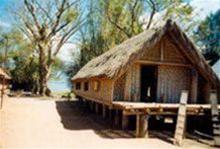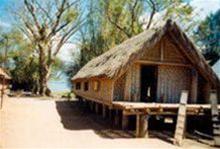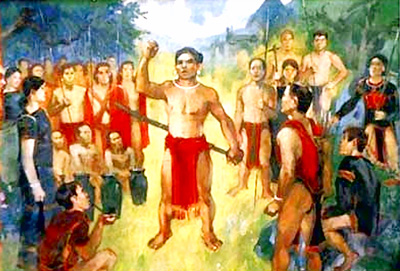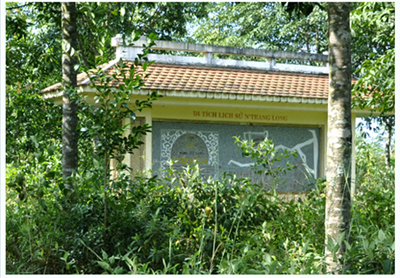
Historical relics and the battlefields of struggle movement to resist French colonialists of the M'Nong ethnic minorities under the leadership of N'Trang Long (battlefields include: Bumera and Bu Nor military post), being located in Dak R'tih and Dak Buk So commune, Tuy Duc district, Dak Nong province. The historical relic was recognized as the national historical relic by the Ministry of Culture, Sports and Tourism in Decision no.04/2007/QD-BVHTTDL, on August 27, 2007.
 |
More than 70 years ago, right here, the resistance to fight against French Colonialists of the M'nong people under the leadership of the chieftain N'Trang Long continuously lasted from the late 1911 to the early 1935, the resistance feft a glorious history of patriotism and solidarity spirit to struggle for the independence of ethnic minorities in Central Highlands.
N'Trang Long, whose real name is Long, he was born in 1870 at Bupar village, a M'Nong Biet village lying below the foothills of Nam Dron around Dak Nha stream, in the north of the M'Nong highland. When he was a child, N'Trang Long was described as a nimble, clever and brave boy. The villagers loved him as well as his little brother Ro Leng Ong. When he grew up, N'Trang Long felt very admiring while he was being listened to and told the struggling examples of the chieftains Ama Jhao, N'Trang Guh.
Since 1909, after Khunjunob's surrender, French started to launch out the military units, misions to spy the M 'Nong highland. The colonial Henri Maitre ordered his troops to capture and build the military post in Bu Poustra village and made an attrack on N'Trang Long's Bu Notrang village, killed his family.
1: the resistance war (from 1912 to 1915). N'Trang Long decided to use 150 insurgent armies attacking and destroying Bu Poustra military post, opened a 25-year long resistance of the M'Nong people.
N'Trang Long's victory made Henri Maitre angry, from 1912 to 1914, French organized many hunting sieges and offered a reward for those who arrested N'Trang Long, but everything was failed. The entire M'nong people determined to follow N'Trang Long to fight against French.
On July 29th 1914, Ro Ong Leng faked a surender and invited Henri Maitre to Bu Nor village to receive the surrender of 400 insurgent armies. Henri Maitre thought that the surrender was true, when he accompanied a group of troops to Bu Nor village, his troops had fallen into the ambush trap of the insurgent army and had been killed by N'Trang Long. From then, the insurgent army repeatedly fought many battles and killed lots of other evil colonials as in battles Buklir and Bu Thong (1914), Sre Lovi (1922).
 |
Phase 2: the resistance war (from 1930 to 1935). In 1928, French army speeded up building the road no.14, the colonial Gatille was in charge of the section from Palklei-Srey Khotum. On January 26th 1931, N'Trang Long ordered insurgent army to ambush and kill Gatille; the death of Gatille made the Governor-General of French Indochina frightened. A protest movement against French spread fiercely out the entire southern region of Highland.
On January 6th 1933, N' Trang Long commanded 300 insurgent armies with guns, bows and crossbow making a raid into the military post no. 65 of French army - a solid military base where had tunnel and barbed wire surrounding. After a day of fighting, French troops must flee. The insurgent army continued to occupy military post and defeated reinforcements, killed the commander Leconte.
In this circumstance, French colonial government decided to destroy insurgent army of N'Trang Long. In February and March 1933, French colonialists mobilized forces with the support of artillery attacking from many directions and opening a devastation at large scale, attacking on Nam Nung military base - one of the most important military bases of N'Trang Long. In this devastation, French troops both attacked by military and burned farming lands, hamlets, villages of the M'nong people at Nam Nung military base to aim at exhausting their supply of food; cornered the M'Nong people and insurgent army of N'Trang Long in poverty situation. N'Trang Long insurgent army fought fiercely. Many battles had taken place at Nam Nung military base and hundreds of enemies had been killed. The struggle lasted all the time.
On October 20th 1933, insurgent army ambushed in Bara mountain, killed the captain Morere; On January 01st 1934, insurgent army attacked Cangrolant military post; on January 02nd 1934, attacked Bukoh military post in Bu Dop; on March 20th 1935, the leader N'Trang Long directly commanded insurgent army destroying Cangrolant military post. After this victory, there was a gang of youths about 500 M'Nong Biet people leaving village, hamlet joined the insurgent army.
 |
In mid-May 1935, French troops concentrated military forces, attacking from three directions: fighting from the southern up, fighting from Cambodia to, fighting from DakLak down. They focused on attacking the headquarter of N'Trang Long insurgent army. Lxing R'ding, who was a tactical commander and the most efficient right-hand of N'Trang Long, had been arrested. The battle against French troops lasted for a long time. The insurgent army severely lacked food, weapons and drugs at Nam Nung military base. After this devastation, French troops set up many military posts such as Hang-ri-met, Boukok, they continued to tighten and surround N'Trang Long insurgent army. Early in the rainy season, 1935, in an unequal struggle, the leader N'Trang Long seriously wounded and fell into the enemy's hands, he died at night on May 23nd 1935.
The ethnic minorities' uprising to fight against French colonialists lasted during 24 years (from 1911 to 1935) under the leasdership of N'Trang Long had been suppressed and extinguished by the enemy. However, with unyielding and solidarity spirit of the ethnic minorities in the struggles against the common enemy of N'Trang Long and his insurgent army encouraged the generations of the people M'nong, Stieng, Ede, Ma, Cham, Kinh, K'ho in Dak Nong, Krong No, Dak Mil...They stood up to fight against the foreign invaders and minions. The life and career of hero N'Trang Long was a historical part of the struggle for national independence of Vietnam before the establishment of the Communist Party. Besides, N'Trang Long's uprising was also a connection between the ethnic minorities in Central Highlands and the liberation escaping from the oppression and exploitation yoke of French colonialists nationwide and the great national unity block of Vietnam national community.
Nowadays, in order to recognize the merit and combat achievements of the M'Nong chieftain. Dak Nong province has been deploying and building the national hero monument N'Trang Long and Central Highlands ethnic minorities in Gia Nghia town centre; besides, the province has also deployed and implemented the project restoring historical relics and memorial places of the struggle movement against French colonialists of M'Nong ethnic people under the leadership of N'Trang Long in Dak R'tih and Dak Buk So commune, Tuy Duc district. The relics include categories: battle zones, tunnels, logistics; battlefields and the victory zones of N'Trang Long movement: Bu Nor village, Bumera military post, Henry Maitre memorial monument. These are also typical relics for the struggle against French colonialists, and the battlefields marked with the glorious and heroic victories of nation, reflecting unyielding and indomitable fighting spirit and the solidarity spirit symbol of the ethnic minorities in Central Highlands.
Editorial Board